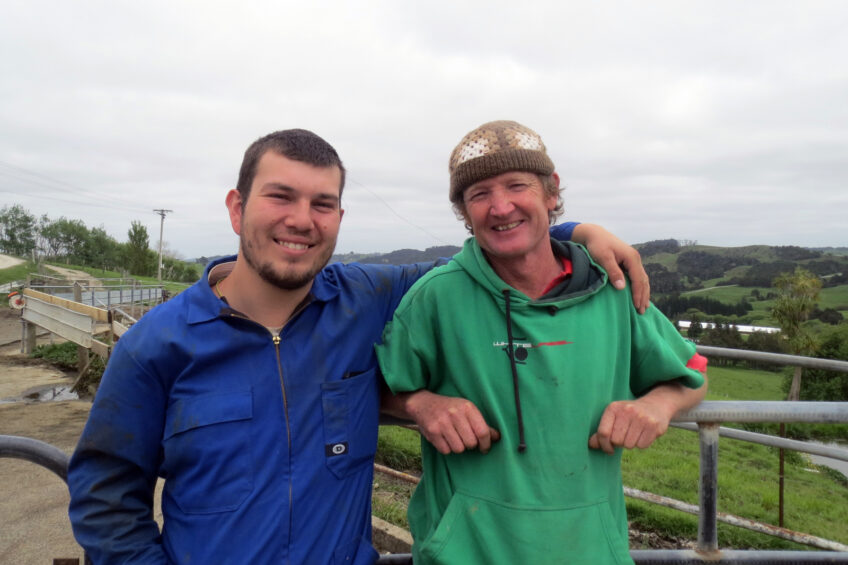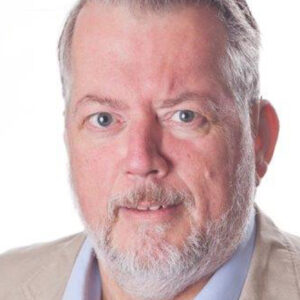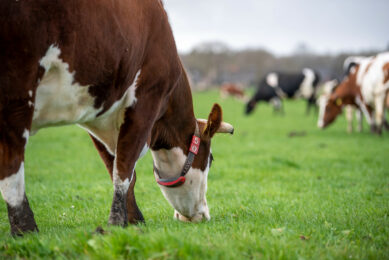Ken Finlaysen dairy farmer: “Growth is no longer a swear word”

New Zealand dairy farmer Ken Finlayson is a true grass farmer. However, the wet climate conditions on the North Island can be challenging to keep the grass green and healthy.
“Experience has thought me many lessons over the years, too many times,” says Ken Finlayson. “I would be in bed, hearing the rain pouring down and I think: It will be all right, let’s doze off for a little while longer. Afterwards, my instincts always appeared to be on point. I should have gotten up and locked the cows that are in the pastures year-round in the waiting area. Such a downpour during the night makes the grassland soggy; the cows destroy our complete pasture in 1 night because of the non-permeable clay soil. I have cried a few times when I saw the grassland the next morning.”
North Island ideal for grass farming
Finlayson is a true grass farmer. He keeps 200 dairy cows on 100 hectares of hilly terrain, mostly grass. In recent years, he started growing fodder plants as a test. “The process of cultivating the plants is going well, but we do not have the proper mechanisation for it and the regional contracting firms lack the means.” The subtropical climate in his region, on the North Island of New Zealand, is very suitable for grass cultivation: 1,400 millimetres of rain every year with mostly warm days and cool nights. On average, daily temperatures reach 26°C. At night, the temperature does not get higher than 13°C. The rain falls throughout the year, with heavy downpours in winter and spring.

A shelter for the cows protects the grassland
“Grassland that is destroyed needs a year to recover and the subsequent lost revenues from grazing cost money. It also disrupts grassland planning and I get extremely annoyed at my own stupidity. This is why we have built a shelter for the cows. Not because they cannot handle heavy rain, but to protect the grassland.” Finlayson has built the covered shelter on a flat piece of land about 300 metres from the milking parlour. The cows can lie in an area of 75 x 12 metres. 1.70 metre poles carry a frame, which in turn carries bows with synthetic tarp. Feeding troughs have been placed on the sides of the outside walls. The cows walk on a 10 centimetre deep sand-lime floor that Finlayson extracts from a quarry just behind the shelter. “When the cows have left, we shovel the manure on a trailer and spread it on the land.”

Separating cows from heifers
The New Zealander finds that it does not bother the cows to stand or lie down in a crowded area. The farmer did learn to separate the cows and the heifers. “That leads to more rest in both groups.” This separation is easy, with the aid of a fence at a right angle from the troughs. Finlayson invested about €15,000 to make this happen. The annual costs of €1,500 easily outweigh the missed revenues of the grass and ‘work wonders on my mood’. The dairy farmer is so happy with the first shelter that he is thinking about building a second smaller one for the heifers, adjacent to the first one. “The available space is not too big and it helps to maintain peace and quiet.”

Quick transition to milking once a day
Finlayson likes his free time. ‘Work hard, play hard’ is his motto. He wants to play golf and squash with his friends three times a week and enjoys going to bars. Finlayson finds that that should be possible, even for dairy farmers. The cows calve in the spring. As soon as the average milk yield is less than 23 kilogrammes, the New Zealander starts milking only once a day. “That mostly happens around 1 November. By milking once a day, the milk yield drops to 20 kilogrammes a day on average. It stabilises at this level for a long time. Most other farmers start milking once a day around 14 December, but that did not work for us. It yielded little financial gain while it had you milking twice a day for a month and a half longer.”

Ken is proud of the fact that he managed to produce 10% more milk solids (kilogrammes of fat and protein) in 2014/2015 from the same livestock than the year before: 70,000 versus 62,000 kilogrammes. This year, production again exceeds that of last year. “The only thing we changed is the grassland management.” The contract worker uses more fertiliser, lots are oversown and re-sown locally. “Last year, we have used 125 kilogrammes of grass seed for overseeding small pieces. That has improved the quality of the turf significantly.”

Name: Ken Finlayson (46) and Scott Donaldson (22)
Residence: Maungaturoto, New Zealand
Company: 200 dairy cows, 35 animals in its young stock and 20 beef bulls on 132 hectares – 94 hectares of which are grassland, divided over 55 lots, two hectares of green maize, two hectares of turnips and two hectares of chicory. In addition to this, the company boasts 32 hectares of forest. The one and two year old animals in the young stock are raised and bred by a third party. Donaldson delivers his milk to Fonterra and receives no external financial funding.
Growth is no longer a swear word, devoting time to dairy farming
For a long time, Finlayson thought he had no successor. His son Scott graduated in information science, but has recently decided to devote his time to dairy farming. “I was not keen on life in the big city and wanted to go back to the country.” He will take over his father’s company in a few years; Scott wants to see the world before settling down. Yet, Scott’s taking over the family business casts a long shadow. Growth is no longer a swear word. Scott carefully mentions that the current 2×18 milking parlour with waiting area can easily handle 240 cows. His father hears him, but shakes his head.
“At the moment, the price is too low to scale up. We have a cost price of $3 per kilogramme milk solids and still reach break-even because feed and the bank do not cost much. I want to be able to pay an expansion like that from my own means. A company free of debt can last for a long time. I do believe Scott is starting to see that now.” Scott agrees with his father. “For a long time, I thought things were not going so well here, but we are doing absolutely great financially, despite our smaller than average size. If we have to expand for the takeover, we can do that. I see many other examples in our region.”
Join 13,000+ subscribers
Subscribe to our newsletter to stay updated about all the need-to-know content in the dairy sector, two times a week.










